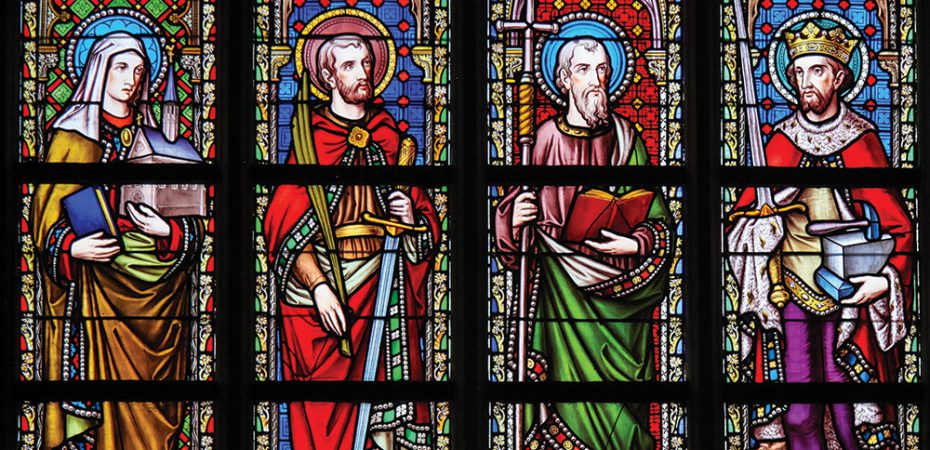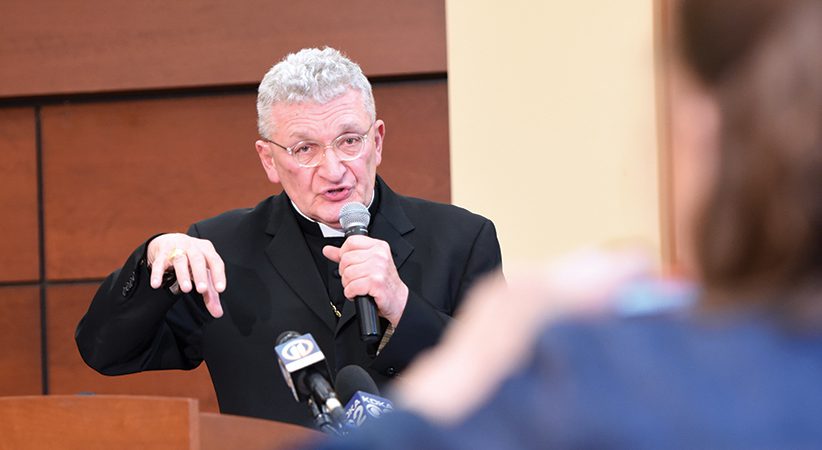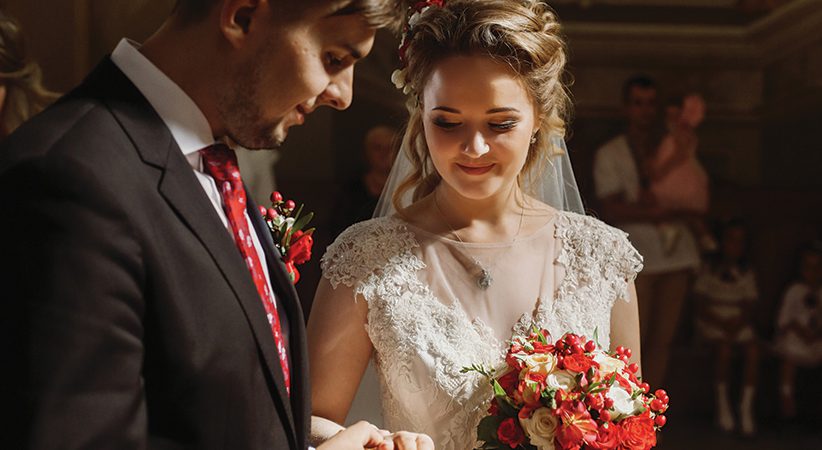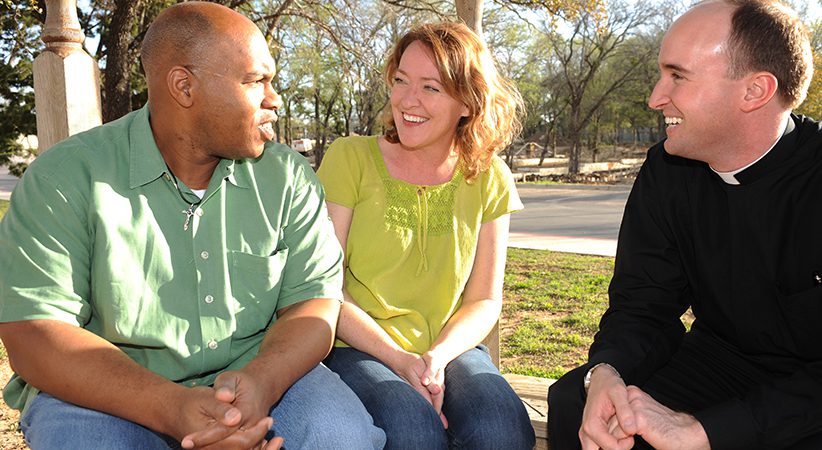The Litany of the Saints
These petitions help draw us into the presence of God
D.D. Emmons Comments Off on The Litany of the Saints
The Catholic Church has many devotions that inspire and enkindle our hearts: receiving the Eucharist, adoring the cross on Good Friday, hearing the words of absolution, participating in a baptism. In each of these actions we are willingly drawn into the presence of God. Many of us respond in a similar way when chanting or hearing the haunting words of the Litany of the Saints. Those prayers and petitions are like a musical score that we remember long after departing the theater, except that the beautiful chant of the litany is not part of a theatrical performance but illuminates a sacred action, a sacramental celebration.
What Is a Litany?
A litany is a series of short invocations or prayers, followed by an equally short response, often repetitive. For example, “St. John the Baptist” (invocation), “pray for us.” (response); “St. Peter, pray for us”; “St. Agnes, pray for us.” A biblical illustration of such a prayer is found in Psalm 136, where there are 26 different petitions, followed by the same response: “for his mercy endures forever.” Another familiar prayer, similar to a litany, is the prayer of the faithful during Mass, when we respond to each invocation with “Lord, hear our prayer” or something similar. Even closer to a litany is the Kyrie Eleison, when the laity respond, “Lord have mercy” and “Christ have mercy.”
While there are different litanies, the most popular is the Litany of the Saints, of which Jesuit Father John A. Harden in his Modern Catholic Dictionary writes: “Called the Litany of the Saints because it is made up of petitions addressed to various saints of different classes, and to Mary, the Queen of the Saints. In its present form, after invoking 48 individual saints, and 13 groups of saints, the litany begs for deliverance from a dozen evils and makes some 30 intercessions, including ‘that you would deign to humble the enemies of Holy Church’ and ‘grant peace and unity to all Christian people.’”
A litany stands alone, meaning it can be used in many ways and to embellish different celebrations including holy orders and baptism.
Litany of the Saints History
There is evidence dating the Litany of the Saints back to the fourth century, and by the sixth or early seventh century it was introduced into different Church processions by Pope St. Gregory the Great (r. 590-604). The litany was chanted during the rogation days devotion from the ninth century until the 20th century when the devotion was removed from the liturgical calendar.
Today this devotion is still can be celebrated, including chanting the Litany of the Saints, but is not widespread in the United States. Rogation (meaning to ask) were three days of penance, fasting and prayer to seek protection for the people and the crops from natural disasters.
| Tradition and Piety |
|---|
|
“The Litanies of the Saints contain elements
deriving from both the liturgical tradition
and from popular piety. They are expressions
of the Church’s confidence in the intercession
of the saints and an experience of the communion
between the Church of the heavenly Jerusalem
and the Church on her earthly pilgrim journey.
The names of the Beati that have inscribed in
the calendars of particular Churches or religious
institutes may be invoked in the litanies of the
saints. Clearly, the names of those whose cult
has not received ecclesial recognition should
not be used in the litanies” (No 235).
|
Praying for the aid of the saints is found in the earliest centuries of Christianity. Church Father Origen (184-253) professed: “I will fall on my knees and because I am unworthy to pray to God on account of my sins, I will invoke all the saints to come to my aid. O ye saints of God, I, filled with sadness, sighing and weeping impose you; intercede for me, a miserable sinner with the Lord of Mercies” (“Mary, Help of Christians,” Benzinger Brothers).
It is not clear who wrote the words to the Litany of the Saints, but it has remained a beautiful part of Church celebrations and devotions for 1,400 years. Some of the public occasions when it is chanted include baptisms, ordinations, Forty Hours devotion, during the solemnity of All Saints Day, during the Mass entrance procession on the First Sunday of Lent. It is also sung as part of certain processions like Corpus Christi. It has become a powerful testimony to our Catholic belief in the Communion of Saints.
There are six Church approved litanies for use during public worship: the Litany of the Saints, the Litany of Loreto, the Litany of the Holy Name, the Litany of the Sacred Heart of Jesus, the Litany of St. Joseph and the Litany of the Precious Blood of Our Lord Jesus Christ. All the litanies can be used any time during private prayer, and reciting one of the approved litanies can result in a partial indulgence, provided all the normal requirements of an indulgence are fulfilled.
Litany of the Saints and the Easter Vigil
The original Litany of the Saints was in Latin and is still widely chanted, but renditions translated into English or other vernacular language are commonly used. A shorter version of the Litany of the Saints is included during the Easter Vigil when adults receive the Sacrament of Baptism. The Rite of Christian Initiation of Adults (RCIA) handbook reads, “The singing of the Litany of the Saints is led by cantors and may include, at the proper place, names of other saints (for example, the titular of the church, the patron saints of the place or of those to be baptized) or petitions suitable to the occasion” (No. 221).
At the Easter Vigil, when there are candidates, the elect, to be baptized, the Litany of the Saints is sung just before the waters of baptism are blessed. The elect who are receiving the sacraments of initiation have selected saints they want to emulate and the name of “their” saint becomes their confirmation name. That saint(s) is added to the list of saints chanted during the litany.
One newly baptized adult said he was initially so electrified by the vigil setting that he didn’t appreciate the significance of everything taking place until he heard the whole church chanting the Litany of the Saints. His reaction for the next few moments was like that of a baseball pitcher who blocks everything out except for the batter and the next pitch. He was mesmerized by the voices filling the church, appealing to that vast crowd of saints surrounding the throne of God. This time was like no other; recognizing that he was about to become not only a Christian but a Catholic Christian, a baptized member of the Church founded by Jesus, a part of something eternal, something holy, something that could only be gifted by God. Those witnessing this sacramental act while appealing to the heavens knew what was happening to the elect, that the generous grace of God was filling the person’s heart, his soul — that he was about to “put on Christ.”
Litany of the Saints and Priest Ordination
During the Mass of ordination, the priest candidate prostrates himself on the floor of the church as part of the litany of supplication. This position brings with it an overwhelming sense of humility, of vulnerability and surrender. As the candidate lays face down, the celebrating bishop initiates the Litany of the Saints, addressing the congregation, saying, “My dear people, let us pray, that the all-powerful Father may pour the gifts of heaven on this servant of his, whom he has chosen to be a priest.”
The cantor then leads those present in the prayerful chant of the litany which, according to one priest, lulled him into a complete state of peace, into a never before experienced emotion.
The candidate doesn’t know all who are praying for him, but in these reverent moments he hears them calling to the countless number of saints, calling them to intercede to God on his behalf. He hears their combined voices lifted in prayer and revels in their affirmation. Recognizing his own call to holiness, he silently promises not to fail these people or his Creator. The litany is like a crescendo before the words of the psalmist, “The Lord has sworn and will not waver, ‘You are a priest forever in the manner of Melchizedek’” (Ps 110:4).
One of those prostrate on the sanctuary frequently included the Litany in his prayers; he well knows that the sacred chant is offered to not only the saints, not only the Blessed Mother, but the Holy Trinity, the angels and archangels — indeed, all the inhabitants of heaven. But he is not prepared that those in the overflowing basilica are offering this sacred prayer for him and for his priesthood. Filled with humility he has difficulty checking his emotions.
Absorbed in this sacred and emotionally charged ritual, the bishop, no matter how often he celebrates the Sacrament of Holy Orders, is mindful of what will confront these new priests: the challenges, the times of joy, the times of despair. The bishop knows that very soon, on any given Sunday, hundreds of the faithful will hang on the words of these newly ordained. No matter the amount of seasoning the bishop attempts to instill, it will be the Holy Spirit who guides them and inspires them to be as “shrewd as serpents and as innocent as doves.” The heartfelt chant of the faithful, their impassioned petitions to all that is holy, provides an uplifting sense of confidence, of community for the priest, the bishop and the Church.
Pope Benedict XVI wrote about his ordination: “I shall never forget lying on the ground at the time of my own priestly and episcopal ordination. When I was ordained bishop, my intense feelings of inadequacy, incapacity, in the face of the greatness of the task was even stronger than at my priestly ordination. The fact that the prayer of the Church really was enveloping and embracing me was a wonderful consolation. In my incapacity, which had to be expressed in the bodily posture of prostration, this prayer, this presence of all the saints, of the living and the dead, was a wonderful strength — it was the only thing that could, as it were, lift me up. Only the presence of the saints with me made possible the path that lay before me” (“The Spirit of the Liturgy,” Ignatius,$19.95).
D.D. EMMONS writes from Mount Joy, Pennsylvania, and is a longtime contributor to OSV publications.
………………………………………………………………………………………………………………………………………………………….
Vatican Directory on Popular Piety
“The Litany of the Saints has been used in the Roman Church since the seventh century. Its liturgical structure is subtle, simple and popular. Through the litany, the Church invokes the saints on certain great sacramental occasions and on other occasions when her imploration is intensified: at the Easter Vigil, before blessing the baptismal fount; in the celebration of the Sacrament of Baptism; in conferring sacred orders of the episcopate, priesthood and diaconate; in the rite for the consecration of virgins and of religious profession; in the rite of dedication of a church and consecration of an altar; at rogation; at the station Masses and penitential processions; when casting out the devil during the rite of exorcism; and in entrusting the dying to the mercy of God.”
…………………………………………………………………………………………………………………………………………………………..





